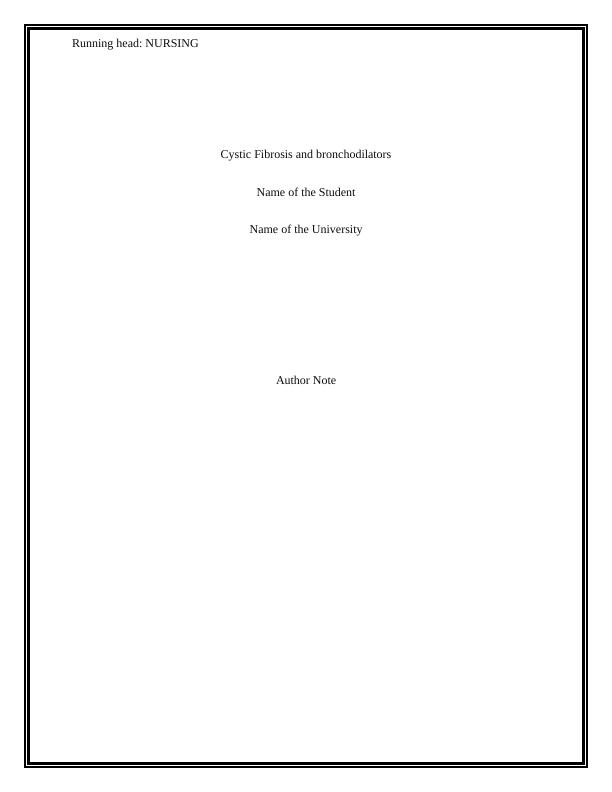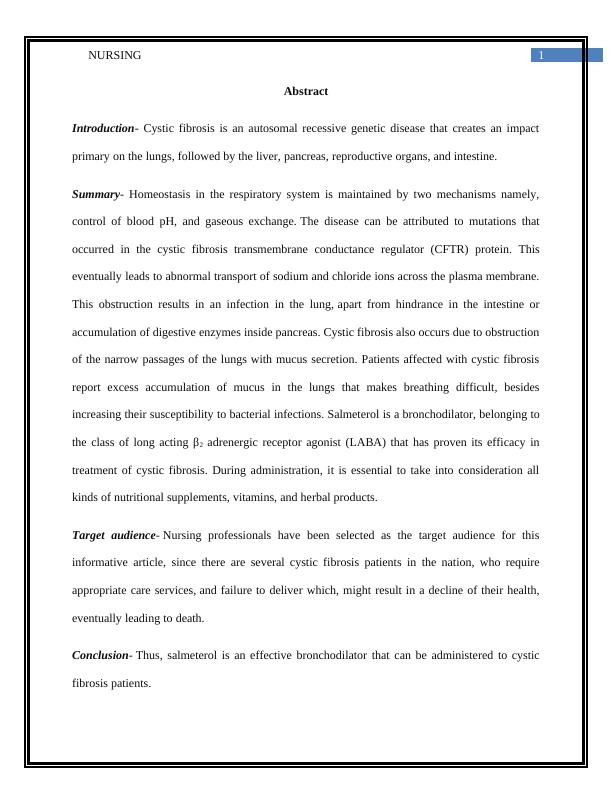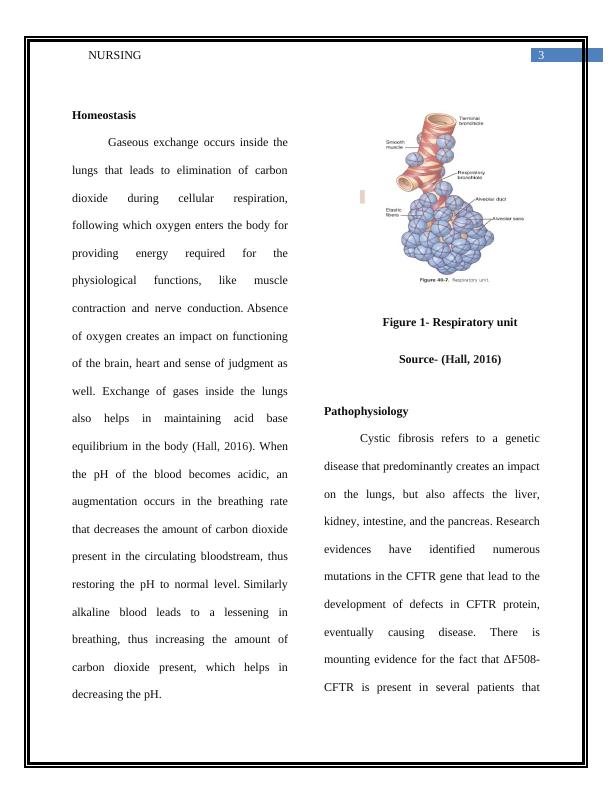Nursing - Cystic Fibrosis and Bronchodilators
Added on 2022-09-11
14 Pages2909 Words11 Views
Running head: NURSING
Cystic Fibrosis and bronchodilators
Name of the Student
Name of the University
Author Note
Cystic Fibrosis and bronchodilators
Name of the Student
Name of the University
Author Note

1NURSING
Abstract
Introduction- Cystic fibrosis is an autosomal recessive genetic disease that creates an impact
primary on the lungs, followed by the liver, pancreas, reproductive organs, and intestine.
Summary- Homeostasis in the respiratory system is maintained by two mechanisms namely,
control of blood pH, and gaseous exchange. The disease can be attributed to mutations that
occurred in the cystic fibrosis transmembrane conductance regulator (CFTR) protein. This
eventually leads to abnormal transport of sodium and chloride ions across the plasma membrane.
This obstruction results in an infection in the lung, apart from hindrance in the intestine or
accumulation of digestive enzymes inside pancreas. Cystic fibrosis also occurs due to obstruction
of the narrow passages of the lungs with mucus secretion. Patients affected with cystic fibrosis
report excess accumulation of mucus in the lungs that makes breathing difficult, besides
increasing their susceptibility to bacterial infections. Salmeterol is a bronchodilator, belonging to
the class of long acting β2 adrenergic receptor agonist (LABA) that has proven its efficacy in
treatment of cystic fibrosis. During administration, it is essential to take into consideration all
kinds of nutritional supplements, vitamins, and herbal products.
Target audience- Nursing professionals have been selected as the target audience for this
informative article, since there are several cystic fibrosis patients in the nation, who require
appropriate care services, and failure to deliver which, might result in a decline of their health,
eventually leading to death.
Conclusion- Thus, salmeterol is an effective bronchodilator that can be administered to cystic
fibrosis patients.
Abstract
Introduction- Cystic fibrosis is an autosomal recessive genetic disease that creates an impact
primary on the lungs, followed by the liver, pancreas, reproductive organs, and intestine.
Summary- Homeostasis in the respiratory system is maintained by two mechanisms namely,
control of blood pH, and gaseous exchange. The disease can be attributed to mutations that
occurred in the cystic fibrosis transmembrane conductance regulator (CFTR) protein. This
eventually leads to abnormal transport of sodium and chloride ions across the plasma membrane.
This obstruction results in an infection in the lung, apart from hindrance in the intestine or
accumulation of digestive enzymes inside pancreas. Cystic fibrosis also occurs due to obstruction
of the narrow passages of the lungs with mucus secretion. Patients affected with cystic fibrosis
report excess accumulation of mucus in the lungs that makes breathing difficult, besides
increasing their susceptibility to bacterial infections. Salmeterol is a bronchodilator, belonging to
the class of long acting β2 adrenergic receptor agonist (LABA) that has proven its efficacy in
treatment of cystic fibrosis. During administration, it is essential to take into consideration all
kinds of nutritional supplements, vitamins, and herbal products.
Target audience- Nursing professionals have been selected as the target audience for this
informative article, since there are several cystic fibrosis patients in the nation, who require
appropriate care services, and failure to deliver which, might result in a decline of their health,
eventually leading to death.
Conclusion- Thus, salmeterol is an effective bronchodilator that can be administered to cystic
fibrosis patients.

2NURSING
Keywords: cystic fibrosis, CFTR, bronchodilator, salmeterol
Table of Contents
Homeostasis.....................................................................................................................................0
Pathophysiology..............................................................................................................................0
Pharmacology..................................................................................................................................2
Name............................................................................................................................................2
Pharmacodynamics......................................................................................................................2
Pharmacokinetics.........................................................................................................................3
Route of Administration..............................................................................................................4
Indications contraindications precautions and side effects..........................................................4
Drug interactions.........................................................................................................................5
Lifestyle changes.............................................................................................................................5
Implications.....................................................................................................................................6
Conclusion.......................................................................................................................................6
References........................................................................................................................................7
Keywords: cystic fibrosis, CFTR, bronchodilator, salmeterol
Table of Contents
Homeostasis.....................................................................................................................................0
Pathophysiology..............................................................................................................................0
Pharmacology..................................................................................................................................2
Name............................................................................................................................................2
Pharmacodynamics......................................................................................................................2
Pharmacokinetics.........................................................................................................................3
Route of Administration..............................................................................................................4
Indications contraindications precautions and side effects..........................................................4
Drug interactions.........................................................................................................................5
Lifestyle changes.............................................................................................................................5
Implications.....................................................................................................................................6
Conclusion.......................................................................................................................................6
References........................................................................................................................................7

3NURSING
Homeostasis
Gaseous exchange occurs inside the
lungs that leads to elimination of carbon
dioxide during cellular respiration,
following which oxygen enters the body for
providing energy required for the
physiological functions, like muscle
contraction and nerve conduction. Absence
of oxygen creates an impact on functioning
of the brain, heart and sense of judgment as
well. Exchange of gases inside the lungs
also helps in maintaining acid base
equilibrium in the body (Hall, 2016). When
the pH of the blood becomes acidic, an
augmentation occurs in the breathing rate
that decreases the amount of carbon dioxide
present in the circulating bloodstream, thus
restoring the pH to normal level. Similarly
alkaline blood leads to a lessening in
breathing, thus increasing the amount of
carbon dioxide present, which helps in
decreasing the pH.
Figure 1- Respiratory unit
Source- (Hall, 2016)
Pathophysiology
Cystic fibrosis refers to a genetic
disease that predominantly creates an impact
on the lungs, but also affects the liver,
kidney, intestine, and the pancreas. Research
evidences have identified numerous
mutations in the CFTR gene that lead to the
development of defects in CFTR protein,
eventually causing disease. There is
mounting evidence for the fact that ΔF508-
CFTR is present in several patients that
Homeostasis
Gaseous exchange occurs inside the
lungs that leads to elimination of carbon
dioxide during cellular respiration,
following which oxygen enters the body for
providing energy required for the
physiological functions, like muscle
contraction and nerve conduction. Absence
of oxygen creates an impact on functioning
of the brain, heart and sense of judgment as
well. Exchange of gases inside the lungs
also helps in maintaining acid base
equilibrium in the body (Hall, 2016). When
the pH of the blood becomes acidic, an
augmentation occurs in the breathing rate
that decreases the amount of carbon dioxide
present in the circulating bloodstream, thus
restoring the pH to normal level. Similarly
alkaline blood leads to a lessening in
breathing, thus increasing the amount of
carbon dioxide present, which helps in
decreasing the pH.
Figure 1- Respiratory unit
Source- (Hall, 2016)
Pathophysiology
Cystic fibrosis refers to a genetic
disease that predominantly creates an impact
on the lungs, but also affects the liver,
kidney, intestine, and the pancreas. Research
evidences have identified numerous
mutations in the CFTR gene that lead to the
development of defects in CFTR protein,
eventually causing disease. There is
mounting evidence for the fact that ΔF508-
CFTR is present in several patients that

End of preview
Want to access all the pages? Upload your documents or become a member.
Related Documents
Cystic Fibrosis: Fact Sheet Articles 2022lg...
|8
|1935
|18
Airway Surface Liquid Homeostasis in Cystic Fibrosislg...
|5
|1024
|77
Cystic Fibrosis Disease Discussion 2022lg...
|2
|326
|29
Nursing and Case Study | Assignmentlg...
|5
|2139
|43
Abdominal symptoms In Cystic Fibrosislg...
|5
|1029
|16
Assignment On Nursing Care Plan.lg...
|8
|1255
|12
